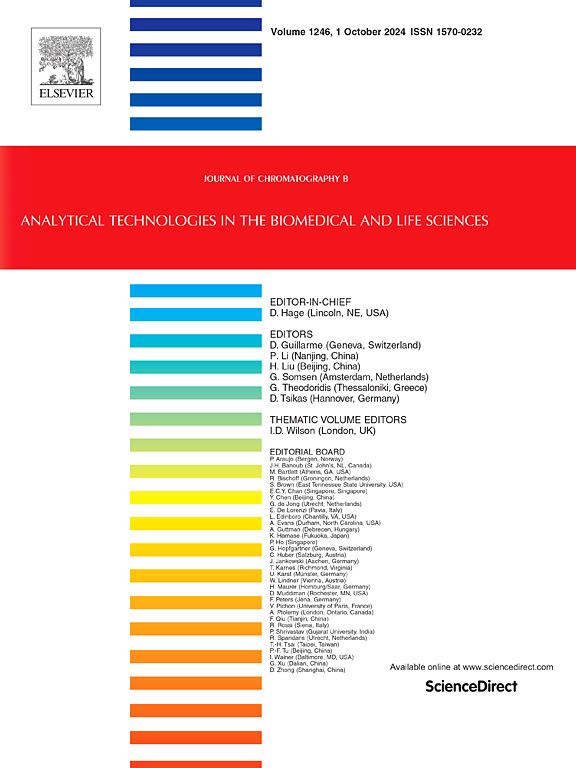Exploring the therapeutic potential of extractions of total flavonoids from Sarcandra Glabra in immune thrombocytopenia: A metabolomic and network pharmacology approach
IF 2.8
3区 医学
Q2 BIOCHEMICAL RESEARCH METHODS
引用次数: 0
Abstract
Sarcandra Glabra is used in the treatment of Immune thrombocytopenia (ITP) clinically. Extractions of total flavonoids from Sarcandra Glabra (ETFSG) can improve platelet count in vivo and in vitro. However, the underlying mechanisms of ETFSG on ITP remain unclear. This study aims to investigate the mechanisms of ETFSG in the treatment of ITP via metabolomics and network pharmacology. Specifically, the number of differentiated megakaryocytes and platelet count in ITP model rats can be enhanced by the administration of ETFSG. Untargeted plasma metabolomics analysis revealed that ETFSG regulates the metabolic disorders of amino acids metabolism, arachidonic acid metabolism, pyrimidine metabolism, and citrate cycle metabolism pathways in the ITP animal model. Metabolomics-based network pharmacology analysis suggests that the PI3K-AKT signaling pathway may be involved in ETFSG's promotion of megakaryocyte differentiation. Western blot results indicate that ETFSG increases the expression of P-PI3K and P-AKT. In summary, these findings lay the groundwork for further exploration of the underlying mechanisms.
利用代谢组学和网络药理学的方法,探索光藤总黄酮提取物对免疫性血小板减少症的治疗潜力
Sarcandra Glabra在临床上用于治疗免疫性血小板减少症(ITP)。菝葜总黄酮在体内外均能提高血小板计数。然而,ETFSG对ITP的潜在机制尚不清楚。本研究旨在通过代谢组学和网络药理学方法探讨ETFSG治疗ITP的机制。其中,ETFSG可提高ITP模型大鼠巨核细胞分化数和血小板计数。非靶向血浆代谢组学分析显示,ETFSG调节ITP动物模型中氨基酸代谢、花生四烯酸代谢、嘧啶代谢和柠檬酸循环代谢途径的代谢紊乱。基于代谢组学的网络药理学分析提示,PI3K-AKT信号通路可能参与了ETFSG促进巨核细胞分化的过程。Western blot结果显示,ETFSG增加了P-PI3K和P-AKT的表达。总之,这些发现为进一步探索其潜在机制奠定了基础。
本文章由计算机程序翻译,如有差异,请以英文原文为准。
求助全文
约1分钟内获得全文
求助全文
来源期刊

Journal of Chromatography B
医学-分析化学
CiteScore
5.60
自引率
3.30%
发文量
306
审稿时长
44 days
期刊介绍:
The Journal of Chromatography B publishes papers on developments in separation science relevant to biology and biomedical research including both fundamental advances and applications. Analytical techniques which may be considered include the various facets of chromatography, electrophoresis and related methods, affinity and immunoaffinity-based methodologies, hyphenated and other multi-dimensional techniques, and microanalytical approaches. The journal also considers articles reporting developments in sample preparation, detection techniques including mass spectrometry, and data handling and analysis.
Developments related to preparative separations for the isolation and purification of components of biological systems may be published, including chromatographic and electrophoretic methods, affinity separations, field flow fractionation and other preparative approaches.
Applications to the analysis of biological systems and samples will be considered when the analytical science contains a significant element of novelty, e.g. a new approach to the separation of a compound, novel combination of analytical techniques, or significantly improved analytical performance.
 求助内容:
求助内容: 应助结果提醒方式:
应助结果提醒方式:


